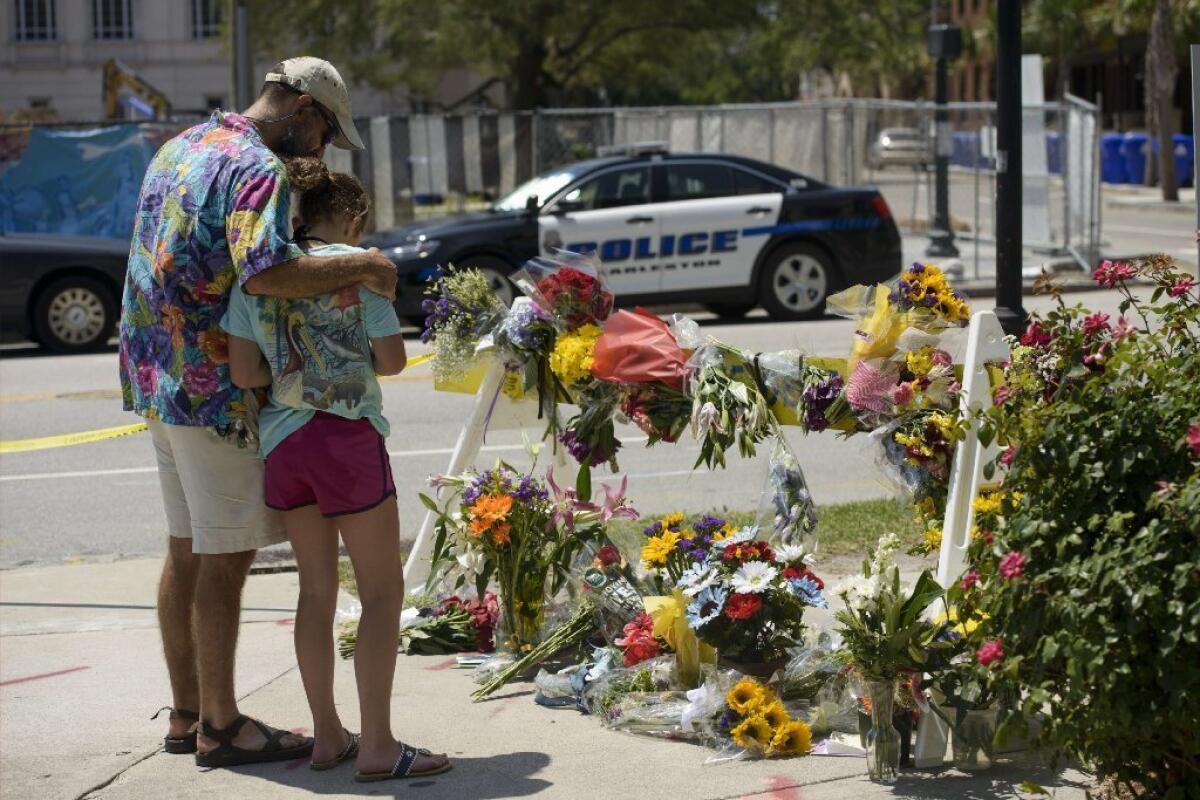You think mass shootings are happening all the time? They are more frequent, data show

Mourners gather before a makeshift memorial near the Emanuel AME Church in Charleston, S.C. Mass shootings like the one in Charleston have become more common in the U.S. since 2011.
- Share via
If it seems like mass shootings are becoming more common, researchers say there’s a good reason: They are.
Between a 2011 shooting at an IHOP restaurant in Carson City, Nev., that left four people dead and the 2013 attack on the Washington Navy Yard where 12 people were killed, a mass shooting occurred somewhere in America once every 64 days, on average.
In the preceding 29 years, such shootings occurred on average every 200 days, according to an analysis by researchers from Harvard University’s School of Public Health and Northeastern University.
The study defined a mass shooting as an outbreak of firearms violence in which four or more victims were killed and the shooter was unknown to most of his victims.
Not only are such shootings more common, they have also become more deadly. In the 10-year period that ended with the Washington Navy Yard attack, 285 people died in such events. In the 13 years before that, 151 people perished in mass shootings.
Between Jan. 1, 2015 and July 20, 2015 there have been 203 mass shooting events in which victims were both killed and wounded by gunfire, according to statistics from Mass Shootings Tracker, a Wiki-style site.
That doesn’t include the two moviegoers who were killed and nine wounded at the Grand Theatre multiplex in Lafayette La., Thursday night.
Although the fatalities in mass shootings are dramatic, they are dwarfed by the number of people killed by firearms in attacks that affect one or two victims at a time and largely escape public notice. The Centers for Disease Control and Prevention estimated that 11,208 people died in homicides involving firearms in the United States in 2013.
Today, American civilians are thought to own as many as 310 million firearms, according to the Bureau of Alcohol, Tobacco and Firearms. A 2012 report from the Congressional Research Service noted that the number of guns per capita had doubled since 1968.
In street violence as in mass shootings, more powerful guns have also made a difference. An Archives of Surgery study that tracked gunshot wounds in a busy hospital emergency room in Washington found that the average number of gunshot entry wounds per patient rose from 1.44 to 2.04 between 1988 and 1990.
The escalation of wounds per patient was consistent with “a shift in weaponry toward high-capacity semi-automatic handguns,” the study authors wrote.
Who are these mass killers? Between 97% and 98% of them are men, according to Columbia University forensic psychiatrist Dr. Michael Stone. Blacks and whites are represented in their ranks roughly proportionate to their percentages in the general population, although Latinos are underrepresented.
While recent mass shootings have prompted calls to keep guns away from those with mental illness, Stone estimated that only about 22% of perpetrators were “deeply mentally ill.”
“Many of them are paranoid and disgruntled, and many are sociopaths,” he said. Many mass shooters — including Jared Lee Loughner, who killed six in a 2011 Tucson shooting that also wounded then-U.S. Rep. Gabrielle Giffords — may flirt with psychosis through drug and alcohol abuse, Stone added.
Hopelessness is a common factor, as evidenced by the fact that nearly half of those committing mass killings either take their own lives or are killed by the police in the immediate aftermath of the event. Many psychiatrists call that outcome “suicide-by-cop.”
Some people, including those opposed to the kinds of gun control measures routinely proposed in the aftermath of mass killings, dispute the claim that such rampages have escalated. Mass shootings are a constant on the American landscape and are more visible thanks to the 24-hour news cycle, they say.
That’s not correct, said Stephen Teret, director of the Center for Law and the Public’s Health at Johns Hopkins University in Baltimore.
“It’s not that they were always occurring and we weren’t aware of them,” Teret said. “People have been collecting these data for a long time.”
But the media attention mass shootings receive can make a difference, particularly if it inspires copycat attacks.
“If each mass shooting increases the risk of the next mass shooting, we need to pay close attention to that,” Teret said.
The trend lines may soon look even worse. In 2013, President Obama ordered that the definition of a mass shooting be changed to one in which three or more people are killed.
By that accounting, more than 300 people died in mass shootings between Jan. 1, 2014, and May 26 this year, according to data from Mass Shootings Tracker.
Twitter: @LATMelissaHealy







